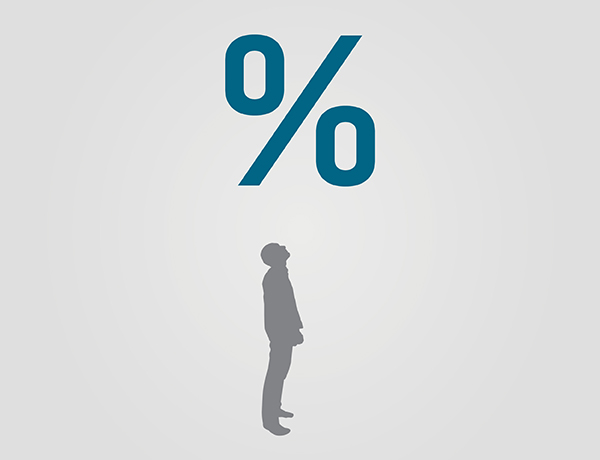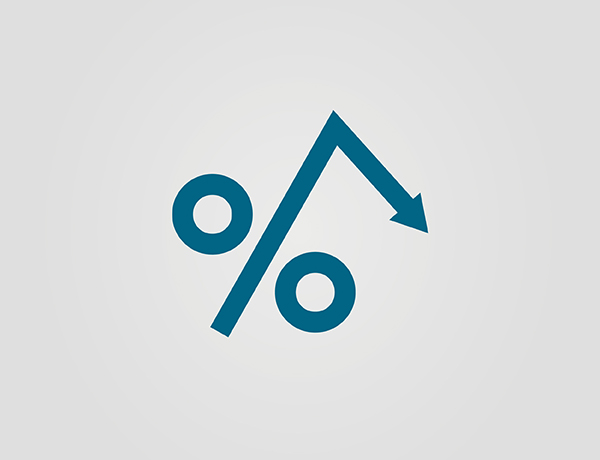Today’s Mortgage Rates February 2023

Feb 28, 2023
Mortgage bonds have broken out of the steep downward trading channel that drove interest rates 1% higher in February and are now trading in a tight sideways channel. This is not likely to hold for long, so we can anticipate a move in one direction or the other in the near term. Until bonds choose which way they will go, the safe play remains to maintain a locking bias.

Everyone’s Turning into a Landlord
Homeowners are justifying moving out of a home with a super low mortgage interest rate by keeping the home as a rental. Rents have moved higher in the past couple of years to where many homeowners who choose to rent their homes have a nice monthly cash flow while still purchasing a new home to move into.
This strategy will allow a home to be rented for up to three years before losing the tax protections when they sell that are currently offered by the IRS. Also, there are ways to access equity from the current home without requiring losing the amazing mortgage rate for the down payment. Using rental income on the home being vacated helps to offset the mortgage expense impact on debt ratios.
Rember the Taper Tantrum?
Those of you who were in the mortgage or real estate industries back in 2013 certainly remember the infamous “Taper Tantrum,” which was a response by investors when the Federal Reserve announced they were going to taper their purchases of mortgage-backed securities. This move sent mortgage interest rates from an average of 3.6% up to 4.75% within a three-month period. This was enough of an increase for the Fed to come out and make statements that the move was too much, too soon.
Well, when you look at the mortgage market today, that level of change has been common for the past 12 months. Not only does this reflect a savagely unhealthy bond market, but it also actually has similarities to moves seen in economically developing countries. We need to see our rate market stabilize to help housing return to a more balanced market.
Appreciation in this Wild Market
The National Case-Shiller Home Price Index was released this morning for the month of December, showing that home values increased by just under 6% year over year. Although this is down from the wild appreciation that we had experienced in the prior two years, it shows we are on a path to return to a more stable housing market. Whether we see prices continue to soften in 2023 is heavily dependent upon mortgage interest rates.
If rates remain at today’s elevated levels, values are anticipated to fall. However, if we see rates drop into the 4.75 – 5.25% range, most anticipate that we will see single-digit appreciation for the year.
Feb 24, 2023
Mortgage bonds continue to show weakness. With mortgage rates continuing to drive higher, we suggest a locking bias.

Inflation is Back!
This morning’s Personal Consumption Expenditures (PCE) report came in showing consumer inflation is on fire, with the Headline rate increasing by .6% in the month of January alone. More importantly, the Core rate, which strips out volatile food and energy prices, also increased by .6%. When you consider this would equate to a 7.2% annualized rate if this were to be consistent for 12 consecutive months, this is not welcomed news to the mortgage bond market.
At this point, we can assume that the Federal Reserve will strongly consider more aggressive rate hikes in the future. While the market was previously anticipating only two 1/4% hikes before pausing, 1/2% hikes are certainly a possibility. Mortgage rates are moving higher on the news.
Is the Mini-Rally Over?
The US stock market is sitting at a critical level as it once again battles its 200-day moving average. A break beneath this would indicate that there is a strong drop in stock prices on the horizon. Many investors anticipate this downward move will occur and are now taking short positions to bet against the market in the near term. Mortgage rates have been moving in opposition to stocks for a while. Therefore, a drop in the stock market would likely correlate to a move higher in mortgage rates.
Inflation Tomorrow
New Home Sales, which measures new homes under contract, rose 7.2% in the month of January. This was much stronger than the market anticipated and matched December’s 7.2% gain. Builders have greatly benefited from the number of existing homeowners who are trapped by a 3% mortgage interest and therefore not willing to sell their homes.
This has dramatically reduced the completion new home builders typically face from the existing home market. We need builders to continue to add new homes to meet the demands of the current potential homebuyer pool. This is good news for the health of our market.
Feb 23, 2023
From a technical standpoint, we are seeing indications that rates could improve from here. Although I am hopeful that tomorrow could be better, it remains risky to float. Do so only if you have the stomach to accept a higher rate should the PCE report deliver bad news.

Good, Not Great
We received the second reading on the 4th quarter 2022 GDP this morning, showing that the US economy grew at an annualized pace of 2.7%. Although this is .2% below what the market anticipated, it is still a strong number. The final revision to the report will come out next month. Hopefully, we will see another downward adjustment.
The Fed has been making unprecedented moves to try to slow down the pace of growth within the US economy. Most economists remain baffled at the sheer resilience of the consumer and the labor market. The Fed has pledged to continue to tighten economic conditions until we see a slowdown.
Jobs are Strong as Ever
Initial Jobless Claims were also reported this morning. Once again, a historically low number of US workers lost their jobs. First-time benefit claims fell to 3,000 from the week prior to 192,000. This shows a savagely unhealthy labor market that is not breaking under the pressure of higher interest rates. We should not expect the Fed to cut rates until we see this weekly number climb above 300,000. Most experts no longer expect that to occur in 2023.
Inflation Tomorrow
Tomorrow we will receive the Personal Consumptions Expenditures (PCE) report showing consumer inflation in the month of January. Given that this is the Fed’s favorite inflation gauge, the reading could help dictate where mortgage rates will go in the near term.
Since receiving a higher-than-anticipated CPI report a couple of weeks ago, mortgage rates have risen sharply. If this gauge shows a bit softer inflationary pressure, rates could recover. However, if this too shows higher than anticipated inflation, we could see rates take another step higher.
At some point, the reality of current inflation will be fully priced in. Hopefully, that peak has now passed.
Feb 21, 2023
There remains no indication as to when the rise in mortgage interest rates will stop. Until that level is found, we will maintain a locking bias.

Mortgage Rates in Uncharted Territory
A significant line in the sand on the mortgage bond chart was broken this morning, which could send mortgage interest rates up another 5/8% before this move ends. On top of the ¾% increase we experienced the past two weeks, this would make for one of the most damaging moves in mortgage bond market history within such a short time. Hopefully, bond prices regain some ground and get above this significant floor that could prevent additional damage. Today’s trading will be extremely important to the near-term future of mortgage interest rates.
Existing Home Sales Decline
Existing Home Sales, which tracks closings on Existing Homes, showed a decline of 0.7% in the month of January. Considering that January is a weak month for home sales, the decline is not a shock to the market. The good news is that we did see the supply of homes on the market increase by 15.3% from a year ago.
However, inventory levels 12 months ago were very low. There is little inventory available for buyers to choose from. We need more sellers to list their homes for us to have any hopes of a balanced market. While doomsday people will use this information to support their belief of a pending market collapse, realize that we are far from the needed level of available homes just to meet current buyer demand, let alone be at risk of a housing crash.
A Recession this Year
The Conference Board’s Leading Economic Indicators fell 0.3% in the month of January, which was the tenth month of consecutive declines. In the past six months, LEI is -7.4%. When this number falls below 0%, it is a recessionary signal. When the number breaks below -4%, the odds of a recession following have been 100%. The Conference Board is predicting a recession to start at some point in 2023. If we do fall into a recession, we can expect to see job losses mount and mortgage interest rates move lower.
Feb 17, 2023
Mortgage bond prices are now battling a VERY significant floor of support. If we make a decisive break beneath this level, it could spell major problems for mortgage rates. Although I am hopeful this will hold, floating remains risky. Do so only if you are able to closely monitor the markets.

Remember the Taper Tantrum?
The rapid rise in mortgage rates over the last two weeks is largely driven by recent reports on the strength of the US labor market as well as continued inflationary growth. This is causing multiple central banks around the world to push the idea that they need to add more ammunition to the fight in the form of higher rates and hold them high for longer.
This reminds me of the days of the “Taper Tantrum,” where news sent mortgage rates blasting higher. I believe this will tame and that the reality of the situation will prove that the US economy is not as strong as currently believed to be. I believe rates will settle soon and we will see lower rates as we move toward the summer months.
Post Holiday Spending
One key red flag in considering whether the economic boom will last is the level of consumer credit card debt. For the first time in history, this amount is pushing the $1 trillion mark. This shows that much of the strong consumer spending has been financed by revolving debt.
As most of us have faced at one point or another in life, when we are over-extended, we eventually are forced to cut back. With credit card rates now nearing 20%, this is certainly a storm on the horizon. Now that the holiday season is over, it seems likely that consumers will slow their spending as they fight to pay down high credit card balances.
Builders are Back!
Not only are consumers facing a debt crisis, but the Federal government is as well. Roughly 4 weeks ago, the US Treasury Department hit its debt limit, which now is waiting on Congress to clear for more spending to be approved. Right now, they are making their payment obligations using “Extraordinary Measures” to free up the cash needed to run the country.
With no clear path in place to reach an agreement to raise the debt limit, the US is facing an eventual default which could create massive economic hardships throughout the country.
Feb 16, 2023
Is the Fed listening yet?
We are hopeful that mortgage bonds will soon find a floor of support that can stop the madness of rates continuing to run higher. We are holding a locking bias.

Drunken Sailors
Yesterday’s Retail Sales report showed that consumers were lighting up the cash registers in the month of January at a pace not seen in nearly two years!
Some of this could be explained by after-holiday shopping, spending the money many received from grandma and their employers for Christmas. Also, it was coming off a dismal December number, so the bar wasn’t set too high. Since one month is not long enough to establish a trend, we will have to see how February’s spending aligns.
If consumers are still spending like drunken sailors, the Fed will take that into consideration at their next policy meeting in March.
Quantitative Tightening… BOOOOO!
The supply of money in the economy continues to fall as the Fed keeps allowing its US Treasuries and mortgage-backed securities holdings to roll off its balance sheet. A process branded, “Quantitative Tightening”.
This trend is a significant headwind to the US stock market, mortgage interest rates, and consumer inflation. It is essentially the undoing of the tremendous stimulus that created the boom in asset prices and drove interest rates to historic lows.
The unwinding process is painful to many industries, especially those tied to the cost of money. Since most home purchases are financed, real estate and mortgage-related careers have been challenging, to say the least. Let’s hope for some relief sooner rather than later.
Builders are Back!
Home Builder Sentiment in the month of February improved to the most significant amount in a decade.
The surge in optimism has sent homebuilder stock prices climbing higher, with some hitting all-time records. With a lack of existing homes on the market to meet demand, builders are reaping the benefits. Unlike a homeowner trapped in a home tied to a 3% mortgage rate, builders are always ready to list when the homes are complete. Since new homes are both more attractive and more available than existing inventory, this is a perfect storm for the homebuilders who did not slow the flow over the fear of higher mortgage rates.
At this level of demand for new homes, multiple offers are common. This real estate environment is going to be tough to correct. The medicine is the disease. Lower mortgage rates which will increase the available inventory of existing homes to put our housing market back into balance.
Feb 15, 2023
Once again, it seems that the disease is also the cure. We need lower rates to help balance the housing market and we need more workers to solve the labor shortages that add upward pressure to consumer prices.
Mortgage interest rates continue to trend higher. Until this upward trend is broken, we remain in a locking bias

Hopes For Lower Rates Are Shrinking
The US housing market is starting to strengthen, which is adding concerns to many economists as well as members of the Federal Reserve. Fed Chairman Jerome Powell has stated multiple times that there is a need for a “reset” in the housing market to help the Fed combat inflation.
Their solution to the unwelcomed development of a resurgence of buyer demand is…. Higher mortgage interest rates. This can be accomplished by the Fed choosing to allow a higher volume of mortgage-backed securities to roll off their balance sheet each month or by outright selling from their portfolio to the open market. At the end of the day, they want the labor market to cool, which would help contribute to the fight against a resurgence of consumer inflation. Higher mortgage rates leading to a slowdown in housing demand would also help accomplish this goal. As hard as this is to stomach, hopes for lower mortgage rates as we head into the summer months of home sales are quickly shrinking.
We Need Some Good News This Month
Yesterday’s strong January inflation report was a real setback for the Fed in its fight to contain price growth. Many Fed members were quick to respond to the news by calling for the Fed to increase their terminal rate goal from the currently planned 5% range to upwards of 6%.
With this CPI report coming shortly after a crazy high report from the Bureau of Labor Statistics showing that 517,000 new jobs were created in the month of January, we know the Fed is feeling there is a lot more to do. The good news is that with the next Fed meeting being more than a month away, we have a couple of opportunities to see if we have lower inflation numbers for February.
Stocks Have Held Up… But…
Now that I have provided one side of the story, let’s review it from a contrarian’s standpoint…
The dilemma leading to a new round of bidding wars has been created by a lack of available homes on the market. With so few homes to choose from, it makes sense to see people who need homes bidding to secure their position. Further, as far as the labor market is concerned, we have yet to see the size of the workforce return to pre-pandemic levels. The lack of available workers creates labor shortages that drive prices higher.
Therefore, the solution is to see more workers have jobs, not fewer. The recent surge in the labor market is healthy and could help reduce labor shortages which in turn helps soften consumer prices.
Feb 14, 2023
Mortgage bonds continue to show negative technical signals. When bond prices are in a strong downward trading channel, the rule is to remain locked until a floor of support proves sufficient to stop the bleeding.

1. Mortgage Rates Will Follow
This morning’s Consumer Price Index report showed that consumer inflation is not coming down anywhere near the pace we need for it to fall.
The Headline number showed a ½% increase in the month of January. When you strip out food and energy prices, the increase was 0.4%. At this pace, we will never reach the Fed’s target rate of inflation of 2% per year, which would require a monthly average increase of just 1.6%. This will further cement the idea that the Fed will need to continue to raise rates, making a 6% terminal rate more likely. We can expect to see mortgage rates climb higher on this news, and possibly climb higher over the weeks to come.
2. Shelter Costs Driving Inflation
Contained within the CPI report is the shelter costs, which is responsible for nearly 40% of the total report. In the month of January, shelter rose by 0.7% and is now up 7.9% year over year.
Since rent increases make up a strong portion of overall shelter costs, we know that 12-month leases that are being renegotiated today are still going to be higher than they were one year ago. We know that 12 months from now, owners will not be able to raise rates at the same pace they have been able to up to this point. Therefore, the shelter component is a lagging indicator that should begin to see improvements in the months to come.
3. Stocks Have Held Up… But…
The US stock market has remained relatively stable for the past couple of weeks. With the index price remaining above its 200-day moving average, there is strong support that should prevent much of a deterioration in the near term.
However, since a higher Federal Funds Rate is not good for the stock market, many expect to see stock prices take a significant hit in the months to come. If you are a short-term trader, be mindful of this risk and watch the market closely. We could see the volume of short position increase, which would indicate an expected downturn.
Feb 13, 2023
Mortgage bonds will respond to tomorrow’s CPI report. If you believe inflation has cooled more than planned, you could benefit from floating. However, I suspect we could see inflation proving to be a little more stubborn last month. Therefore, I am a bit less optimistic about tomorrow’s report.

Bad News For Mortgage Rates
Many are predicting a strong fall for the US stock market after investors seem to have prematurely predicted an early Fed pivot that now seems unlikely.
This expected drop in stock prices would come at the same time that corporate profits are reporting much lower earnings than the market anticipated. Stocks have suffered from the Fed draining liquidity from the system. With the days of easy money now behind us, this isn’t good news for either stocks or mortgage rates. As the nation adapts to this new reality, we should see more buyers and sellers bite the bullet and accept a higher mortgage rate in exchange for a home they love. The next few months will show one way or the other how accepting buyers will be.
Storage Facilities Are Bursting at the Seams
As we wait to hear what tomorrow’s Consumer Price Index (CPI) report shows for price gains in the month of January, logistic managers are warning of a strong increase in storage costs that should soon be hitting consumer prices. Rather than facing shortages as the reason behind the increase in consumer prices, we are now facing excess supply that has warehouses and storage facilities bursting at the seams.
Remember how during Covid oil producers were paying companies to take their excess oil, which drove the price of oil down to multi-year lows? We could soon see retailers cutting their prices to help move excess inventory from the warehouses. It seems better to cut costs to move products than to pay more to store over-priced, unwanted goods.
Jobs… Not as Good as it Seems
Most economists who believe we will avoid a recession point to the strength of the labor market to justify their position. They are missing that in 100% of cases in the last 40 years, a recession followed shortly after the unemployment rate hit a cycle low. With the unemployment rate currently sitting at the lowest level since 1969, smart money would bet that the next move is for a rise to this rate followed immediately by a recession. Jobs are always the last to go in a recession and job losses generally happen after a recession has begun. So, using the strength of the labor market as justification could prove to be the wrong indicator to support a forward-looking outlook as a recession indicator.
Feb 10, 2023
The bond market is once again breaking all technical support levels. With no indication as to when the damage ends, we will continue with a locking bias.

1. Will the Terminal Rate Hit 6%?
This is a full 1% higher than the 5% rate the market currently has priced in. With the current rate at 4.58%, this would mean we have roughly 1.5% in rate hikes to go. This would not be good for the mortgage market or for real estate values, as higher rates would create downward pressure on home values.
Although this is still not a likely scenario, this theory is being pushed hard by many social influencers and media commentators. Let’s hope that inflation numbers continue to fall and that the labor market begins to show weakness so we can put this fear in the market to rest.
2. We See Demand Increasing
Some housing markets are beginning to see a resurgence of multiple offers on listed homes. This is a result of a lack of available homes and buyer’s becoming more comfortable with the reality of higher mortgage interest rates. With average income growth over the last 12 months strong, combined with home prices becoming more stable, more consumers are ready to buy. With the strong purchase season just around the corner, we can expect to see demand for housing increase.
3. Appreciation Looks Nice 😉
Interest rates have made a strong climb higher the past week as investors consider the new risks of the Fed hiking higher than planned. Recently, Deutsche Bank warned that the yield of the 10-Year Treasury Note may rise to 4.2% by the end of 2023 as the US economy recovers.
They are assuming that any recession will be mild and very short-lived. If this were to play out, we would expect to see mortgage rates climb back over the 7% threshold. We could see other economists follow with predictions of higher rates soon.
Feb 8, 2023
Mortgage bond prices have been flirting with breaking beneath the floor of support that has prevented rates from taking another step higher. We will continue to float while at the bottom of the trading range. However, if they do break beneath, we will switch to a locking bias.

1. 🤖 Terminator Terminal Rate 🤖
Yesterday’s speech by Fed Chair Jerome Powell set the stage for a possible Fed Funds terminal rate that is higher than the 5% peak the market has been anticipating.
Although he said that the disinflation process “has begun”, he cautioned about stronger-than-expected economic data. “If we continue to get strong labor market reports or higher inflation reports, it may well be the case that we have to do more and raise rates more than is priced in,” he said. This is not great news for hopes of lower rates in 2023.
Unless the job reports start to show losses sufficient to keep wage-based inflation contained, rates will remain higher for longer.
2. AI: Good for Rates, Maybe Bad for Humans
The introduction of ChatGPT is sure to change how many companies do business. Elon Musk once said that AI is one of the greatest threats human civilization faces. Given the number of man-hours humans spend writing, ChatGPT is sure to replace the work of many employees across the world.
Since this improves worker productivity, this will help to drive wages lower and cut many jobs. Overall, that will help contain inflation, which is good for the longer-term outlook for mortgage interest rates. Clearly, this will pose concerns to many industries that could soon find that they will no longer be relevant to businesses and consumers. With innovation comes change. Let’s hope we are ready for this one.
3. Appreciation Looks Nice 😉
According to Core Logic, home values across the United States are anticipated to increase by 3% in 2023. This is a good number and flies in the face of the many who have been predicting a massive housing crisis. Clearly, we are very far from being in a distressed housing market.
The housing recession that began early last summer is a product of a lack of inventory caused by homeowners not willing to trade in their sub-3% mortgage rate to purchase a home with a rate that was as high as 7.375% at one point. A 3% rate of appreciation is meaningful to market stability as well as long-term wealth creation. This is great news as we head into the busy buying season for 2023.
Feb 7, 2023
Mortgage bond prices are once again fighting an important floor of support. Since the general rule is to float when at the bottom of a trading channel, we will maintain our floating bias. Be watchful in case the floor breaks and prices move lower.

Smoke & Mirrors
The blockbuster job report that we received last Friday is a lot of smoke and mirrors. When you compare how many full time workers we have today vs. last May, we now have fewer today. The key take away from this is many of the new jobs shown in the numbers are from part time workers. They could be workers who have primary jobs taking on second jobs to help fight higher costs due to inflation.
This is generally not a good sign for the US economy, nor is a major boost in part time jobs something we can count on lasting long term. Many will quit their second job when they get their finances back in alignment or when they burn out from being over worked.
The Money supply decreased
The money supply is down 1.3% from the peak level in 2022. This is a significant reduction, which is highly deflationary. The over supply of money spurred by the Federal Reserve’s massive investment into mortgage bonds and treasury notes as well as the US Treasury’s excessive Covid relief spending created a glut of money in the financial system.
The excess money drove up consumer demand for goods and services that businesses were not able to keep up with. As the money supply reduces at the same time the supply of products catches up to consumer demand, we will continue to see inflationary pressures moderate.
Central Banks… You Gotta Stop
Fed Chairman, Jerome Powell, is set to speak today. Markets responded well to his most recent comments when he acknowledged the disinflation prepress has begun.
However, following last Friday’s strong labor market announcement, many fear that Powell will step up his staunch stance against a savage unhealthy labor market that threatens to spur another inflationary cycle.
Many now expect the Fed to drive the terminal Fed Funds Rate even higher, with some now expecting the Fed to continue to drive rates up to 6%. Although this doesn’t seem likely, the market could respond poorly to any indication of rates increasing higher than the two 1/4% hikes the market has priced in.
Feb 6, 2023
After rates moved higher in early morning trading, we are hoping to see the new floor of support level hold. We will suggest floating to see if this level holds.

Credit Card Debt Hits New High in Q4
At the same time, credit card rates are nearly 20% and climbing.
As balances have risen, so have delinquencies. This is an early recession indicator that could be predicting trouble on the horizon. If the Federal Reserve continues to drive higher rates, the problem will likely deepen. In the past, consumers have used their home equity to consolidate revolving debts. For this to be an option, we need to see mortgage rates soften.
An Unfortunate Breakout
We were spot on when we said we would likely see mortgage bonds breakout of the trading channel that had held mortgage rates somewhat stable for several weeks.
Unfortunately, the breakout was to the downside, which has caused mortgage rates to take a big step higher. Breakouts are met with a strong move immediately afterward, especially when the attempted breakout involves the 100-day moving average. Unless mortgage bond prices can quickly recover, we will likely be trading in this higher rate range until we see further signs of a slowing labor market or inflation.
Central Banks… You Gotta Stop
Central bankers worldwide are doing exactly as we feared by going out and talking tough about the need to continue global monetary tightening to slow inflationary growth. They feel it is a greater risk to under-tighten and risk a resurgence of inflation. This rhetoric is adding upward pressure on mortgage rates.
Jan 31, 2023 – Mortgage bonds continue to trade in a predictable channel. We could see bond prices make a break in one direction or the other following tomorrow’s Fed announcement. In the meantime, there is no need to immediately rush to lock.

3 THINGS TO KNOW
1. The Light at the End of the Tunnel 💡
Today is day one of the Federal Reserve’s two-day Open Market Committee meeting, ending tomorrow at noon when they likely announce a 1/4% rate hike to the Fed Funds Rate. This will be the smallest hike, indicating that we are near the end of the rate hiking cycle.
After tomorrow, there are one or two additional 1/4% increases anticipated and then a pause. How long the Fed will hold rates before making a cut is largely dependent upon the labor market. Fed members want to see weakness in what has been one of the strongest job markets in many decades before they loosen monetary policy.
2. A Little Help From Mortgage Rates
The Case Shiller Home Price Index showed home prices fell 0.6% in November. Before the holiday season, we typically see a slowdown in the housing market, so this is not a surprise. When you combine the timing along with rising mortgage interest rates, this drop is not as sharp as many anticipated.
Now that we are likely heading into a prolonged period of rates moving lower, we can expect to see housing market activity improve. This will help support home values and keep any fears of a housing market crash from becoming reality.
3. Deflation… You Remember What That Is?
There is deflation in the rental market, with the Apartment List report showing rents fell 0.3% in January. Although there was an annual increase of 3.3%, it’s down from the 3.8% annualized gain in the previous report.
Although it will take a number of months for this drop to be reflected in the Consumer Price Index inflation report, it will certainly help show lower inflation in the months to come. That is good news for mortgage rates as we head into the stronger purchase summer season.
Jan 30, 2023 – If the bond market floor holds, we will suggest floating.

3 THINGS TO KNOW
1. We’ve Got Our Eyes on You Two
There are two signs of pending weakness that we are looking for in this week’s reports on the health of the US labor market. First, we want to see if Thursday’s new unemployment claims report shows a step high in the number of workers continuing to receive unemployment benefits. A move higher in this number shows that it is getting more difficult for unemployed workers to find replacement jobs.
Then in Friday’s BLS report, we want to see if employers are cutting back on the number of hours their employees work each week. Cutting hours is a step that is taken prior to layoffs. We are now in the second-strongest labor market since data began being tracked in the late 1930s.
We need to see a pullback before the Fed will consider softening rates. These two data points will help us better predict when that may happen.
2. Stocks are Done With the Gloom
After a solid run, the stock market is under pressure. The good news for stock investors is that the S&P 500 index is above its 200-day moving average. This allows stocks to pull back as they prepare for another run higher. If the Fed only delivers a ¼% rate hike on Wednesday as planned, we could see stock investors interpret this as the first step in a Fed “Pause.”
That could push stock prices to rally even higher.
3. Our Fingers are Crossed 🤞🏻
Mortgage bonds have been trading in a highly predictable channel for several weeks. Given the strength of the floor of bond prices, we should have protection from rates moving much higher in the near term. Since we are now near the bottom of the trading channel, we can expect to see a slight improvement in rates today or tomorrow.
However, bond investors may hold out for the Fed announcement on Wednesday before making any aggressive moves.
Jan 27, 2023 – Mortgage bonds remain trapped in a tight range. Since they are now technically at the bottom of the range, we hope to see improvement as the day wears on. We will suggest a floating bias while we wait to see if bond prices are able to bounce off the floor.

3 THINGS TO KNOW
1. Directionally Accurate
Although today’s Personal Consumption Expenditures (PCE) report showed that consumer inflation was in line with what the market anticipated, the bond market was apparently looking for an even lower number. As a result, mortgage rates are flat from where they ended the day yesterday.
The Core rate showed a month-over-month increase of .3%, which helped bring the annualized rate down from 4.7% to 4.4%. While this is a long way from the Fed’s target rate of 2%, it is still trending in the right direction.
2. Hasta la vista, baby!
Pending Home Sales are also trending in the right direction, rising 2.5% in the month of December. Although we are still down 33% from this time last year, it is encouraging to see this number improve. According to the National Association of Realtors, the low point in sales activity is likely behind us. As mortgage interest rates improve over the coming months, we can expect to see inventory levels improve and more buyer demand in the market.
3. Next Week May be Better
Next week is another big week for mortgage interest rates, highlighted by the Fed rate announcement on Wednesday and the Bureau of Labor Statistics’ estimate of job growth for the month of January set to be released on Friday.
Since today’s consumer inflation report hasn’t yet helped mortgage rates break beneath the strong floor of support, hopefully, one of next week’s reports will provide rates with the boost they need to improve.
Jan 26, 2023 – If you have the stomach to take a risk, you may benefit by floating into tomorrow’s report.

3 THINGS TO KNOW
1. GDP is Still Strong
GDP estimates for the 4th quarter of 2022 were released this morning, showing that the US economy grew at a 2.9% annualized pace. This is .3% higher than what the market anticipated and shows a surprisingly resilient economy. It is widely anticipated that as we see the Fed rate hikes take hold, we will see a much lower pace of growth in 2023.
Along with the labor market, the Fed needs to see this number fall before it considers cutting rates. If they cut rates while the US economy is still growing at a historically rapid pace, it would just make things even stronger.
2. Jobs Comming In Above Expectations… is the Expectation
Initial Jobless Claims for last week were reported at only 190,000. This is 19,000 below what the market was anticipating and once again shows a savagely unhealthy labor market.
We need to see this number rise above 300,000 to see the desired level of weakness in the workforce that would help the Federal Reserve feel more confident that we will not see a resurgence of consumer inflation. Rate hikes are the counterbalance to a growing workforce. The higher the rate, the more pressure on the labor market.
3. Our Fingers are Crossed 🤞🏻
Volatility in the mortgage market is high this morning. We have watched mortgage bond prices bounce between the ceiling and the floor. Investors will be waiting to make large moves until after the release of tomorrow morning’s Personal Consumption Expenditures (PCE). If the Core pace of inflation comes in below expectations, it could trigger a drop in mortgage interest rates. 🤞🏻
Jan 25, 2023 – Mortgage bond prices bounced off the floor we mentioned in yesterday’s update, which has slightly improved rates. Now that we are approaching the top of the trading channel, the risk of short-term volatility is elevated. If you are a risk taker, you may benefit by waiting to lock until after Friday’s report.

3 THINGS TO KNOW
1. People Need Homes to Live
The segment of the population who believed the housing market would collapse and that we would see new home listings spike higher is learning that this housing recession is very different from that of 2008. We all know the “guy” on Instagram who has been adding fear to US consumers regarding the risks of owning a home and how we are going to see the housing market collapse.
He has certainly done a good job of scaring people. What he is missing is that homeowners today are not over-leveraged. They have fixed-rate mortgages with very low interest rates, so there is no reason mass numbers of homes should be vacated. At the end of the day, housing is shelter, it is not an investment that can be sold under the threat of a real estate downturn.
People need homes to live in.
2. Housing is Hungover 🤢
Mortgage applications continue to climb higher, which is a leading indicator for homebuying activity in the future. The challenge now will be the lack of available listings to support the coming buyer demand. We need for mortgage rates to fall to a level where sellers are willing to let go of their 3% mortgage rate. Today’s market is the “hangover” from the ultra-low rate environment we all benefited from in 2020 and 2021. Now the goal will be for the market to find a balance somewhere in the middle.
3. Small Business is the Hold-Out
The US stock market has been wildly volatile over the past few weeks. However, the S&P 500 index is now trading above its 200-day moving average, which is providing hope that stocks could see a rally coming soon.
If Friday’s Personal Consumption Expenditures report shows that consumer inflation is under control, that could be interpreted by stock investors as a reason for the Fed to pause future rate hikes. Since rate hikes hurt the US economy, a pause is good news for the stock market.
Housing Minute
What you need to know in 60 seconds… every Tuesday
Jan 24, 2023 – While we are at the bottom of the trading channel in early morning trading, we are likely to see mortgage rates improve a bit as the day wears on. If you choose to float, watch the markets closely. A break beneath the channel would trigger a locking bias.

3 THINGS TO KNOW
1. The Debt Limit Debate
The disagreement between political parties on our national spending debt limit is putting the credit rating risk of the US government in question. If an agreement is not made soon, we will start to see certain federally funded programs and services stall. Since a significant amount of our nation’s spending comes from the Federal government, this has the potential further to slow the growth of our already decelerating economy.
This would also make it more difficult for the Federal Reserve to continue to drain liquidity from the system through its Quantitative Tightening program. If the Fed is forced to change its position, we could see mortgage interest rates improve.
2. Everything’s Pointing Toward a Recession
The December Leading Economic Indicators report showed a 1% decline. This has been declining for 10 straight months and is now down 4.2% in the last six months alone. This has historically been a strong recessionary indicator, which is now flashing warning signs of a likely recession by the second quarter of 2023.
3. We Get Inflation on Friday
Mortgage bonds have been trading in a highly predictable channel for nearly three weeks. Given the importance of Friday’s consumer inflation report, it is likely that we will see a break from this channel in one way or the other. If the report shows consumer inflation has stalled, we could see mortgage rates improve.
Although that seems to be the likely scenario, there is always the possibility of an upward surprise that could cause rates to move higher. Let’s hope we see lower inflation. Our housing-related industries must see mortgage rates return to more reasonable levels.
Jan 23, 2023 – Mortgage bonds continue to trade in a well-defined channel. We will continue our locking bias for now.

3 THINGS TO KNOW
1. Higher Pay + Equity
The US supply of homes for sale just crossed a bottom floor of 1,000,000 homes. To put this into perspective, this is 3,200,000 fewer homes than were on the market in 2008. This lack of supply is what is holding home values from falling and is largely created by homeowners not willing to sell their homes and trade their 3% mortgage for one that is two times as high.
Most homeowners now are making significantly more income now than they did prior to the pandemic and are easily able to manage their 30-year fixed mortgage payments. This is a far cry from the market of 2008 when many had adjustable mortgage rates and were already pushing the boundaries of what they could afford. Most importantly, homeowners today have far more equity in their homes and are therefore not likely to walk away as we saw happen in 2008.
2. Will Shipping Costs Take Rates with Them?
Shipping costs are falling drastically as retailers catch up on pent-up demand. During the Covid lockdowns, many manufacturers were unable to produce products that buyers were still wanting to purchase. The inflationary pressures we have been experiencing were heavily driven by the lack of supply.
As we see supply chains catch up, we will move from having an inflation problem to being concerned about deflation. This will be good news for mortgage rates and could drive rates lower than most economists believe. Let’s hope that is the case.
3. We Get Inflation on Friday
Friday is a big day for the mortgage market, as the Personal Consumptions Expenditures (PCE) report for the month of December will be released. This is the inflation report that the Fed uses for its 2% target. Since housing costs are not as heavily weighted in this report as in the CPI report, we could see the number shows that we are in a deflationary market already. Although the annualized number will still be high, it is likely that inflation is not currently an issue.
Jan 20, 2023 – With mortgage rates facing upward pressure, we will maintain a locking bias.

3 THINGS TO KNOW
1. The Muscle 💪💪
The US labor market is once again flexing its muscles, with the number of weekly unemployment claims coming in at a mere 190,000. This shows incredible strength and is not what the Federal Reserve was hoping for. If the labor market is this strong in a year where we had a 4.5% increase to the Fed Funds Rate, what would happen if rates were lower?
Again, we need the labor market to break. The Fed Funds rate will likely remain high until this happens. “Higher rates for longer” could be the mantra for 2023.
2. We Need Some Collaboration
The US Federal Government hit its debt limit on Thursday. Without an agreement between democrats and republicans, we are now at high risk of defaulting. Treasury Secretary Janet Yellen is taking extraordinary measures to allow payments to continue to retirees and Americans who rely on monthly checks to sustain life.
Hopefully, our dysfunctional politicians can figure out a mutually beneficial outcome soon. It is not good for the highest credit-ready provider of debt to default.
3. Waiting on the Next Report
After mortgage rates once again hit the floor that they have been battling, interest rates are bouncing higher. It could take either the next inflation report or a softening tone from the Federal Reserve to allow mortgage rates to fall.
Jan 18, 2023 – Mortgage rates are battling a critical floor that could prevent improvement. Until we break this floor, floating is risky.
By mid-year, I expect to see a continued weakening of the US economy. This will also further drive mortgage rates lower. If you have a mortgage that you can refinance at a rate where we cover the fees, now is the time. We will take steps down as rates continue to fall by using options where we cover all closing costs.

3 THINGS TO KNOW
1. More Layoffs
Microsoft is set to announce thousands of layoffs today, in what is yet another blow to the tech industry. Large corporations have essentially led the job losses in recent months. We are still waiting on small employers to begin to cut workers. When this happens, we can hopefully get to where we are seeing weekly jobless claims move to the 300,00 – 325,000 level. This will be needed for the Fed to start making accommodations that will further drive down mortgage rates.
2. Are Supply and Demand Back in Style?
Inflation on the wholesale level is falling like a rock, with the headline number showing that manufacturing prices dropped by .5% in December. Once again, we are showing that we have moved from having an inflation problem to being in a deflationary environment.
Factories are clearly dropping their prices now that supply and demand are more in line. Clearly, the pent-up demand allowed many manufacturers and suppliers to drive their prices higher. It is now time for everyone to get their pricing back in line with a longer-term more stable market. The days of high profits and high margins at the expense of the consumer are quickly fading.
3. Retail is on the Ropes
Retail Sales fell by 1.1% in the month of December. This is also deflationary and shows that the rate hikes of the Federal Reserve have been accomplishing the goal of slowing the US economy. With interest rates higher, consumers are spending more money to finance large purchases, which is deterring many from digging themselves deeper into debt.
Jan 17, 2023 – Mortgage rates remained trapped with a strong floor preventing further improvement. There is little chance of a breakthrough today. Therefore, we will maintain a locking bias.

3 THINGS TO KNOW
1. The Credit Card Crisis 💳
Since the great financial crisis, we are experiencing the fastest rise in credit card delinquencies. At the same time, we are experiencing a rapid drop in saving rates. What does this predict? A recession.
When money dries up, Americans tend to maintain their lifestyle for a period of time after they run out of cash and finance the additional spending on credit. This is where we’ve found ourselves. It is a dangerous path that will not end well. Unless, of course, mortgage rates fall and consumers can once again afford access to home equity to consolidate their debts. Let’s hope this happens.
2. A “Soft Landing” is Now or Never
I firmly believe the path to a “soft landing” is for the Fed to pause rate hikes NOW. They have a terrible track record of over-correcting in either direction. This is not likely to be an exception to their prior mistakes. The hawkish tone of the Fed and the obsession with their comparison of the 1970s to today should not be overlooked.
This is not the same financial environment of the 1970s, nor is the reason for our inflationary issues remotely similar. The Fed is led by a group that is overly focused on the rearview mirror and is not accurately seeing what is coming.
They need to stop before it is too late for any hopes of a soft landing.
3. Manufacturing in America is Nose-Diving
…further pointing to a recession ahead.
Shipments are way down, the opposite issue we had just one year ago when companies could not keep up with buyer demand. This will eventually trickle down to impact small business owners, which seem to be the final holdouts preventing our labor market from slowing.
Jan 13, 2023 – We say lock as we are at the top of a trading range.

3 THINGS TO KNOW
1. It’ll Take a Lot to Break this Ceiling
Mortgage bonds responded well to yesterday’s CPI report that showed the current pace of consumer inflation is well on track to get within the Fed’s target rate of 2%. However, after hitting a strong technical ceiling, the gains in the bond market have stalled.
This is an important level that will likely take fresh bearish comments from the Fed before this ceiling can be broken. With that in mind, we could see the current levels of mortgage rates be as low as they will get in the near term.
2. Follow the Smart Money
There remains fear in the markets of a repeat of the 1970’s era resurgence of consumer inflation that will push mortgage rates to 8% – 10%. This fear also seems to be driving the Federal Reserve. The Fed has repeated many times that history shows that pulling back too soon could lead to deeper issues. The real experts to follow are bond investors.
They have proven time and again to be more accurate in their long-term inflation expectations. If the bond market believed we would see rates exceeding 8%, the 10-Year Treasury yield will be well above 5%. Since this has been falling, they clearly do not see inflation being a long-term issue.
3. It’s Time to Lock In
The S&P 500 once again hit its 200-day moving average. As we have seen throughout the entire year of 2022, this is an indication we will see stocks fall sharply. Since mortgage rates have generally moved higher as stocks fall, this is not a good sign for the near-term direction of rates. Be mindful of this if you have a loan that you are currently floating.
Jan 12, 2023 – Mortgage bonds are experiencing a high level of volatility in early morning trading. I believe we will see the market settle and rates improve. We will suggest a floating bias as we look to see how the market interprets the data.

3 THINGS TO KNOW
1. The Hikes are Working
The Consumer Price Index (CPI) report showing consumer inflation for the month of December was released this morning. As expected, headline inflation reported a .1% decline. This shows that not only is inflation cooling, but that we experienced ‘deflation’ last month. However, when you take out volatile food and energy prices, we saw a .3% gain.
When you look at the current annual rate, which averages the past 12 months of inflation, the headline number fell from 7.1% down to 6.5%. This really isn’t a fair number to follow, as the most recent 3 months have shown that current inflation is only running at a 1.6% clip. Clearly, the market is feeling the impact of the Fed’s recent rate hikes.
2. Home Expenses are Falling…
One key point of the CPI report is the Shelter component. Since this makes up more than 1/3 of the total, we need to consider the dynamics of this number and how it plays into the total. In a way that most economists can’t rationalize, ‘Shelter’ had its largest month-over-month gain since 1985.
Wait! what?? Home prices fell on average ½% last month, and rent fell by .8%, so why were shelter costs so high? Well, the way the modeling works, there is a 6–12-month lag in the shelter data. Therefore, since current months are showing declines, this will further drive down the monthly overall inflation numbers. In short, current inflation is not running as high as the report would imply.
3. Small Business is the Hold-Out
The number of new unemployment benefits claims last week was reported to be only 205,000. This is an insanely low number and shows that the labor market appears to remain radically strong. This comes at a time when we are hearing of mass numbers of layoffs happening at many large companies. Once again, small business owners seem to be the strong point in the labor market. However, as they see their bank balances fall, they too will eventually begin to lay off workers.
Jan 9, 2023 – Mortgage bonds are performing well so far in early morning trading. At this point, there is no immediate need to lock it. Carefully watch the market and be prepared to lock should the sentiment reverse.

3 THINGS TO KNOW
1. Housing market forecast
Housing market predictions for 2024 have been released. As I’m sure you can guess, the estimates of how home values will perform this year will depend on mortgage rates. If average market rates don’t fall well below 6%, many economists expect to see home values fall by around between 5-7.5% in 2024.
However, if rates drop below 5%, we will likely see a strong resurgence in buyer demand which will help values remain stable or possibly single-digit growth. A 2-4% growth rate is healthy and would undoubtedly be welcomed.
2. Is a soft landing a possibility?
Bond investors seem to have interpreted Friday’s BLS Job report as a goldilocks scenario, where we can still maintain high job growth but with more moderate wage growth that would not accelerate inflation. This gives hope that the Fed can still create a soft landing for the US economy. Remember that jobs are always the last to go before a recession hits.
We are already witnessing large businesses begin to lay off. Once the small and medium-sized companies start to cut, we will see the prospects of a soft landing deteriorate. The way to help avoid this is for the Fed to allow market interest rates to fall to where the housing market stabilizes.
3. The end of rate hikes could be closer than we think
I believe that by the end of the first quarter 2023, we will see the last rate hike in the current tightening cycle of the Fed. The question will then turn to how long the Fed will hold before they begin to cut. Most expect this to happen in late 2023 or early 2024. Since mortgage rates are market-driven, not set by the Fed, we will see mortgage rates fall ahead of the Fed cutting rates.
Jan 5, 2023 – Whether to lock or float into tomorrow’s job report is a difficult decision. Although I expect to see a weaker-than-anticipated BLS number, we have also had many months of shockingly high reports. The risk of floating remains elevated.

3 THINGS TO KNOW
1. Now is the time to cash-out
It will soon be more difficult for homeowners to access home equity. Freddie Mac has announced a new rule that will require new buyers to wait for a full 12 months before they are able to use a value above the original purchase price for the purpose of a cash-out refinance. This means that buyers who purchase at below market value will not be able to recoup the difference with a cash-out Freddie Mac mortgage.
Although Fannie Mae has not yet announced a change, we do expect them to follow suit. Further, a homeowner will not be able to do a cash-out refinance within 12 months of their most recent mortgage closing. This angle is a bit more difficult to understand. However, the new rules will likely be implemented soon. If you or a client needs a cash-out refinance, now is the time to consider.
2. Jobs continue to NOT disappoint
ADP released their estimate of new job creations in the month of December, and once again it was a blockbuster. While the market was expecting just 150,000 new jobs, the actual report came in at 235,000.
The strength of the labor market is the key issue the Federal Reserve is looking to break. We need to see the labor market soften and more workers become unemployed. Tomorrow’s Bureau of Labor Statistics (BLS) report will be the one that helps set the near-term direction of mortgage rates. Let’s hope the report shows weakness in the labor market.
3. Small and medium-sized business is doing fine
With the major layoff announcements from companies like Amazon, SalesForce, and FedEx, it seems that we would be seeing weaker numbers reflected in the job reports. However, while large companies are shrinking, we are seeing small to medium employers add to their employee count.
Small employer balance sheets have been well-padded in recent years, which is one reason why they continue to grow. At some point in 2023, it is expected that we see this trend break and even small employers shed labor.
Jan 4, 2023 – The bond market generally doesn’t respond well to Fed Meeting Minutes. Floating into the report comes with great risk.

3 THINGS TO KNOW
1. This could go one of two ways
Today we will receive the meeting minutes from the Federal Reserve’s December 13-14th FOMC meeting. The fear surrounding this report lies within the Fed’s statements that they now believe inflation will linger for longer. The Fed changed its inflation outlook for the end of 2023 to be at 3.1% compared to its prior estimate of 2.8%.
It is likely we will learn the reasoning behind this change, which could again spark fear in the bond market. On the other hand, the minutes could also acknowledge that the Fed is effectively reducing inflation, which could create help the market rally. Let’s hope for the latter.
2. Santa Clause Rally 🎅
Many mutual fund managers were forced to reallocate their portfolios by the end of 2022 to align with stated ratios. This often helps to contribute to what is called the Santa Clause Rally, where stock investments gain value as a result. 2022 was an exception to this, where we didn’t see the typical growth in the stock market.
Now that fund managers have a bit more freedom, we could see a nice shift back into the bond market. Most are expecting 2023 to be a much better year for bonds than we had in 2022. This would be good news for mortgage rates, as mortgage bonds could benefit from the flow of money into fixed-return assets.
3. PCE is a big deal
This is Job’s Week, with the first of two important readings on the growth of the labor market coming by means of ADP tomorrow. More importantly, Friday will be the release from the Bureau of Labor Statistics. Given that recent readings have shown a relentless strength of the US labor market, December’s report will influence the near-term direction of mortgage interest rates.
The Fed wants to see the labor market weaken. A strong report would give the Fed permission to continue the path of rate hikes into 2023.
Housing Minute
What you need to know in 60 seconds… every Tuesday
Jan 3, 2023 – There remains little reason to float. We will maintain a locking bias.

3 THINGS TO KNOW
1. There’s Further Down From Here
2023 is already off to a rough start for stock investors, with the S&P 500 falling below 3800. We are nearing a meaningful floor of support that if broken, we seem poised to fall down below the 3500 mark. From a technical perspective, things are not looking good for the stock market.
Given that bond prices have seemed to fall as stock prices fall, this is also not good news for mortgage rates in the near term. The best hope for a stock and bond market recovery could be a recession. Once a recession hits, stocks generally start to rise as markets regain hope for more support from the Fed.
2. So You’re Saying There’s a Chance
Speaking of recession, warning indicators of a looming recession are in full force. In fact, some indicators are showing a 100% probability that the US economy will fall into a recession, which is not good news for those who still believe the Fed can pull off a “soft landing.” It seems likely we will see this happen at some point in the next six months.
3. Like 2008 but Entirely Different
The US Housing Market is also off to a rough start in 2023. However, not in the same way we experienced 2008 when home values fell sharply and many homeowners lost their homes. Home equity is strong, so far the labor market is holding and most homeowners have fixed rates below 4%.
We don’t expect this dynamic to change until we see mortgage rates fall below 5%. As difficult as it will be, we need more workers to lose their jobs and for the Us economy to fall into a recession. At that point, we could see our housing market improve.



